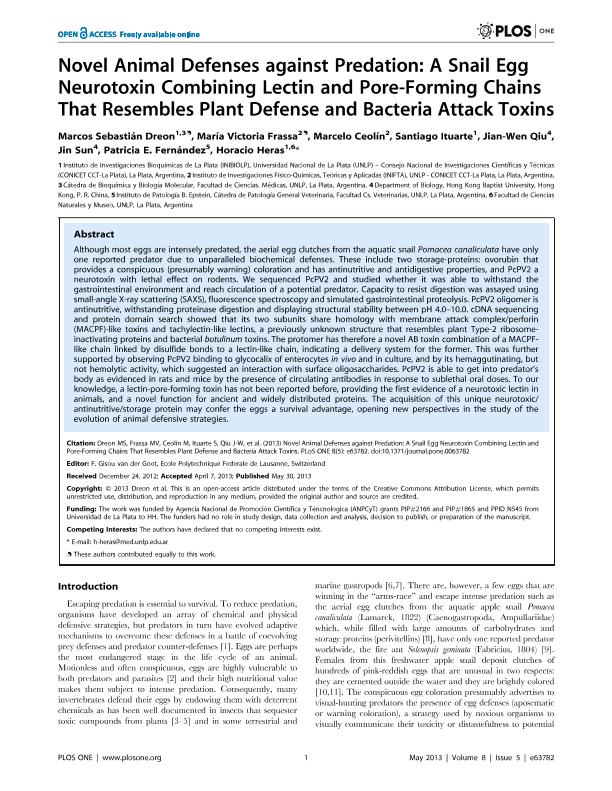Mostrar el registro sencillo del ítem
dc.contributor.author
Dreon, Marcos Sebastian

dc.contributor.author
Frassa, Maria Victoria

dc.contributor.author
Ceolin, Marcelo Raul

dc.contributor.author
Ituarte, Santiago

dc.contributor.author
Qiu, Jian Wen

dc.contributor.author
Sun, Jin
dc.contributor.author
Fernández, Patricia Elena

dc.contributor.author
Heras, Horacio

dc.date.available
2015-12-16T18:29:20Z
dc.date.issued
2013-05
dc.identifier.citation
Dreon, Marcos Sebastian; Frassa, Maria Victoria; Ceolin, Marcelo Raul; Ituarte, Santiago; Qiu, Jian Wen; et al.; Novel Animal Defenses against Predation: A Snail Egg Neurotoxin Combining Lectin and Pore-Forming Chains That Resembles Plant Defense and Bacteria Attack Toxins; Public Library of Science; Plos One; 8; 5; 5-2013; e63782
dc.identifier.issn
1932-6203
dc.identifier.uri
http://hdl.handle.net/11336/2962
dc.description.abstract
Although most eggs are intensely predated, the aerial egg clutches from the aquatic snail Pomacea canaliculata have only one reported predator due to unparalleled biochemical defenses. These include two storage-proteins: ovorubin that provides a conspicuous (presumably warning) coloration and has antinutritive and antidigestive properties, and PcPV2 a neurotoxin with lethal effect on rodents. We sequenced PcPV2 and studied whether it was able to withstand the gastrointestinal environment and reach circulation of a potential predator. Capacity to resist digestion was assayed using small-angle X-ray scattering (SAXS), fluorescence spectroscopy and simulated gastrointestinal proteolysis. PcPV2 oligomer is antinutritive, withstanding proteinase digestion and displaying structural stability between pH 4.0-10.0. cDNA sequencing and protein domain search showed that its two subunits share homology with membrane attack complex/perforin (MACPF)-like toxins and tachylectin-like lectins, a previously unknown structure that resembles plant Type-2 ribosome-inactivating proteins and bacterial botulinum toxins. The protomer has therefore a novel AB toxin combination of a MACPF-like chain linked by disulfide bonds to a lectin-like chain, indicating a delivery system for the former. This was further supported by observing PcPV2 binding to glycocalix of enterocytes in vivo and in culture, and by its hemaggutinating, but not hemolytic activity, which suggested an interaction with surface oligosaccharides. PcPV2 is able to get into predator's body as evidenced in rats and mice by the presence of circulating antibodies in response to sublethal oral doses. To our knowledge, a lectin-pore-forming toxin has not been reported before, providing the first evidence of a neurotoxic lectin in animals, and a novel function for ancient and widely distributed proteins. The acquisition of this unique neurotoxic/antinutritive/storage protein may confer the eggs a survival advantage, opening new perspectives in the study of the evolution of animal defensive strategies.
dc.format
application/pdf
dc.language.iso
eng
dc.publisher
Public Library of Science

dc.rights
info:eu-repo/semantics/openAccess
dc.rights.uri
https://creativecommons.org/licenses/by/2.5/ar/
dc.subject
Egg Protein
dc.subject
Macpf
dc.subject
Lectin
dc.subject
Perforin
dc.subject.classification
Bioquímica y Biología Molecular

dc.subject.classification
Ciencias Biológicas

dc.subject.classification
CIENCIAS NATURALES Y EXACTAS

dc.subject.classification
Zoología, Ornitología, Entomología, Etología

dc.subject.classification
Ciencias Biológicas

dc.subject.classification
CIENCIAS NATURALES Y EXACTAS

dc.title
Novel Animal Defenses against Predation: A Snail Egg Neurotoxin Combining Lectin and Pore-Forming Chains That Resembles Plant Defense and Bacteria Attack Toxins
dc.type
info:eu-repo/semantics/article
dc.type
info:ar-repo/semantics/artículo
dc.type
info:eu-repo/semantics/publishedVersion
dc.date.updated
2016-03-30 10:35:44.97925-03
dc.journal.volume
8
dc.journal.number
5
dc.journal.pagination
e63782
dc.journal.pais
Estados Unidos

dc.journal.ciudad
San Francisco
dc.description.fil
Fil: Dreon, Marcos Sebastian. Universidad Nacional de la Plata. Facultad de Ciencias Médicas; Argentina. Consejo Nacional de Investigaciones Científicas y Técnicas. Centro Científico Tecnológico La Plata. Instituto de Investigaciones Bioquímicas de La Plata; Argentina
dc.description.fil
Fil: Frassa, Maria Victoria. Consejo Nacional de Investigaciones Científicas y Técnicas. Centro Científico Tecnológico la Plata. Instituto de Investigaciones Fisicoquímicas Teóricas y Aplicadas; Argentina
dc.description.fil
Fil: Ceolin, Marcelo Raul. Consejo Nacional de Investigaciones Científicas y Técnicas. Centro Científico Tecnológico la Plata. Instituto de Investigaciones Fisicoquímicas Teóricas y Aplicadas; Argentina
dc.description.fil
Fil: Ituarte, Santiago. Consejo Nacional de Investigaciones Científicas y Técnicas. Centro Científico Tecnológico La Plata. Instituto de Investigaciones Bioquímicas de La Plata; Argentina
dc.description.fil
Fil: Qiu, Jian Wen. Hong Kong Baptist University. Department of Biology; China
dc.description.fil
Fil: Sun, Jin. Hong Kong Baptist University. Department of Biology; China
dc.description.fil
Fil: Fernández, Patricia Elena. Universidad Nacional de la Plata. Facultad de Ciencias Veterinarias. Cátedra de Patología General Veterinaria; Argentina
dc.description.fil
Fil: Heras, Horacio. Consejo Nacional de Investigaciones Científicas y Técnicas. Centro Científico Tecnológico La Plata. Instituto de Investigaciones Bioquímicas de La Plata; Argentina. Universidad Nacional de la Plata. Facultad de Ciencias Naturales y Museo; Argentina
dc.journal.title
Plos One

dc.relation.alternativeid
info:eu-repo/semantics/altIdentifier/url/https://journals.plos.org/plosone/article?id=10.1371/journal.pone.0063782
dc.relation.alternativeid
info:eu-repo/semantics/altIdentifier/doi/http://dx.doi.org/10.1371/journal.pone.0063782
Archivos asociados
